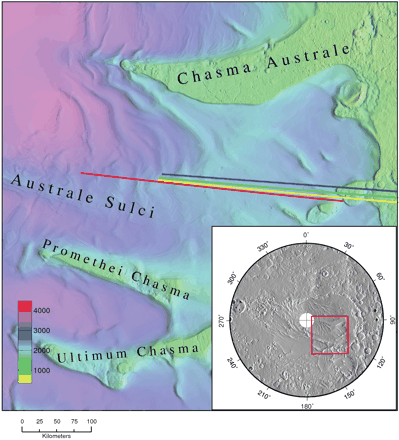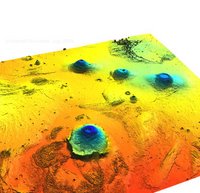Planetary mapping
GIS Support
- GRASS lat/lon regions may be used as 0-360 longitude, not just 180 east+west.
- In GRASS 6 you can set and add custom ellipsoids, see the g.setproj module. Permanently adding custom ellipsoids can be done by hand, the config tables for that are plain self-documenting text files, so reasonably easy to edit. An ellipse table with planetary spheroids (to put as $GISBASE/etc/*.table files) is available here.
- GRASS 7 now includes the planetary ellipsoid tables and support is present in the wxGUI location wizard.
Open Issues
- r.out.gdal exports 'unknown' ellipsoids / datums, and also the reference meridian is named 'Greenwich'
Example of the use of GRASS GIS in Planetary Research
GRASS ps.map output as published in an article in the journal Science.

Data
Data summary (1999):
http://publish.uwo.ca/~pjstooke/mapsummy.txt
Modules
- r.in.gdal will handle HDF and netCDF and many many more formats
- r.in.bin will load raw binary data
- see also the GRASS and GMT wiki page for interfacing with GMT Mapping Tools
Mars topography

See tutorial in GRASSNews volume 1:
- Global dataset of bathymetry and topography. GRASS Newsletter, 1:8-11, August 2004. ISSN 1614-8746.
Screenshots
See also
- Frigeri, A, Hare, T, Neteler, M., Coradini, A, Federico, C, Orosei, R. (2011). A research environment for digital planetary data processing and mapping using ISIS and GRASS GIS. Planetary and Space Science, 59(11-12), pp.1265-1272 [ DOI | PDF ]
- these just define the simple reference ellipsoids, so dx=dy=dz=0.
- GRASS currently uses the IAU2000 definitions in the ellipse.table.solar.system file.
- ...